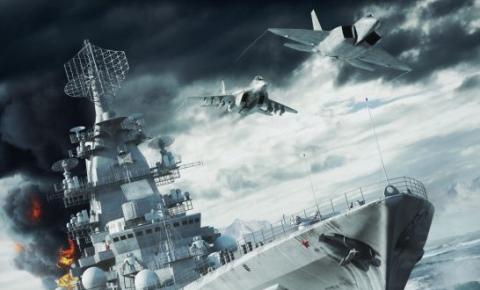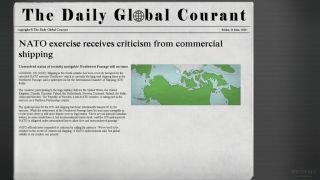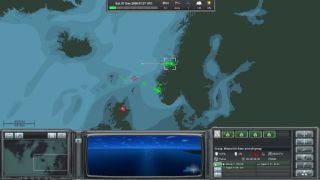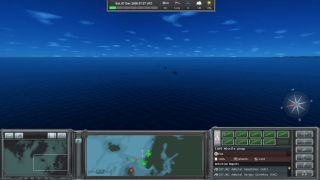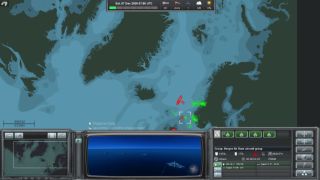I wonder how it might be to actually serve on a ship that is ready to go to war, filled with men, tools of destruction and ammunition, complete with a number of high-tech weapon systems and the knowledge that the other side has quite a few plans to choose from when it comes to killing everyone on board and sinking the warship.
Naval War: Arctic Circle will not help me find an answer to this question, but the naval battle simulator from Turbo Tape Games and Paradox Interactive will allow anyone interested in modern warfare on the sea and in the air to experience a simulation that abstracts a lot but still manages to feel visceral and engaging.
Story
In the near future, a conflict is brewing between a resurgent Russia and the forces of the North Atlantic Treaty Organization over a new maritime passage that is opened up by global warming.
The player takes on the role of an officer in either of the two forces and needs to complete missions that are drawn up by their commanders, ranging from simple search and destroy to escort and intelligence gathering.
The story is a little more than a pretext to go out and do battle on the sea and in the air, but the development team has taken care to offer a human touch when it comes to the briefings, which are filled with subtle humor and often read like a sort of light comedic take on Hunt of the Red October and other classic sea war movies.
There’s a lot of writing in Naval War: Arctic Circle, yet most of it is employed not for the narrative but to describe the various weapons and electronics systems used on the ships, planes and submarines that players use.
It might seem a little daunting at first, but it pays to read all the text in order to be clear on what each unit and what weapon systems can do and to learn how to best use them on the battlefield.
In addition, you should make sure you are always clear on the text of the mission briefing in order to avoid situations like those I found myself in, taking out loads of enemy planes (and feeling happy about it) just as the submarines I was supposed to stop were slipping through my detection net in order to reach undefended shipping lanes.
Gameplay
There are two campaigns in Naval War: Artic Circle, one for a stripped-down NATO and one for good old resurgent Russia, the perfect adversary when it comes to modern war, be it in first-person mode or in the strategy genre.
There are clear variations in the way they are balanced and scripted and require different approaches. Yet, the basic concept is the same: you receive a number of objectives, including one linked to a limit on losses, evaluate the hardware that you can use, create and then execute a plan that will allow your forces to reach all objectives with limited losses.
Initially, Naval War seems a pretty easy game, but soon the “unknown unknowns” that Donald Rumsfeld was talking about surface and I discovered that repeated trial and error was necessary to progress, alongside a big dose of prudency and some understanding of basic tactics.
One of the biggest challenges in Naval War is choosing when to deploy active detection and when to shut it off, and the decisions the player makes at the start of the stage often have long-term effects that tend to make the difference between success and failure.
Blinking radars all over the place will make it easier for the enemy to plan his movement around the map in order to avoid detection and will also make your units easier to target and destroy.
Relying too much on passive detection will mean the player misses out on important intelligence and makes it impossible to achieve objectives within the given timeframes.
Because of the lethality of modern rockets and torpedoes, the core ways of delivering deadly kinetic energy both in the real world and in Naval War: Arctic Circle, actual engagements are quick and deadly and that puts an even bigger emphasis on the detection games.
The developers tend to compound the difficulty by making it impossible to save in the middle of the level, which could be a selling point for hardcore sim lovers but will certainly be a problem for those who would like to test strategies and choices without replaying the entire mission they just went through with a degree of success.
Graphics and audio
Naval War: Arctic Circle is clearly aimed at the type of player who cares little about the number of polygons on his F-35, a lot about the equipment the plane is carrying and about the correct name of its weapons systems.
Looking at the way fighters move across a sea that never seems to change and at the decidedly unsexy carriers that NATO gets access to, I sometimes wished that the development team at Turbo Tape had made the game even more stylized, dropping any direct way of looking at the units or replacing them with art matching the one seen during the briefings
These are cartoonish and get the point of the game across while their schematic nature is well suited to the overall atmosphere of Naval War: Arctic Circle, the bleakness linked to wagging long range war in the North, with the sea and cold constant companions.
The current compromise between the tactical look and the tracking shots of the various hardware (you can even trail missiles and torpedoes) will probably leave both camps somewhat unsatisfied.
One major disappointment was that the briefing conversations, at times very funny while always keeping the appearance of serious military talk between high-level commanders, are not voiced in any way, meaning that I needed to put in the extra effort and imagine accents and affectations instead of just sitting back and enjoying the slowly increasing insanity of war.
The music for Naval War: Arctic Circle is a little out of place given the subject matter, but it’s easy for those who don’t like it to switch on their favorite music player and put on some battle marches to better get into the atmosphere.
Multiplayer
The single player in Naval War: Arctic Circle is, in many ways, just a prelude to the real epic battles taking place in the multiplayer mode, where gamers can choose their side and then jump into the fray of the North in order to reap glory by defeating their enemies, sinking their ships and taking down aircraft.
The kind of gamer who buys Paradox Interactive published titles and enjoys sea-based strategy tends to be very considerate and easy going. Yet, as always, it’s a good idea to play with someone you know, especially when it comes to the first few matches, where defeat is pretty much guaranteed when going against a player with some previous experience.
The gameplay is mostly engaging and interesting, even though sometimes defeat by A.I. surprise is almost unavoidable, and the presentation and graphics are suited to the theme, although they might put off some gamers who are expecting detailed units and full motion video briefings. As long as you have any kind of interest in modern warfare and warships, take a look at the demo for Naval War: Arctic Circle and see what kind of gameplay it has to offer before actually spending money on it.
The Good
The Bad
Conclusion
 14 DAY TRIAL //
14 DAY TRIAL // 